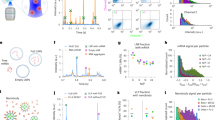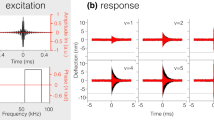Abstract
We have developed a sensitive, economical method that directly detects viruses by making use of the interaction between type 1 herpes simplex virus (HSV1) and specific antibodies covalently attached to the oscillating surface of a quartz crystal microbalance (QCM). The virions were detached from the surface by monotonously increasing the amplitude of oscillation of the QCM, while using the QCM to sensitively detect the acoustic noise produced when the interactions were broken. We term this process rupture event scanning (REVS). The method is quantitative over at least six orders of magnitude, and its sensitivity approaches detection of a single virus particle.
This is a preview of subscription content, access via your institution
Access options
Subscribe to this journal
Receive 12 print issues and online access
$209.00 per year
only $17.42 per issue
Buy this article
- Purchase on Springer Link
- Instant access to full article PDF
Prices may be subject to local taxes which are calculated during checkout




Similar content being viewed by others
References
Dultsev, F.N., Ostanin, V.P. & Klenerman, D. “Hearing” bond breakage—measurement of bond rupture forces using a quartz crystal microbalance. Langmuir 16, 5036–5040 (2000).
Ward, M.D. & Buttry, D.A. In situ interfacial mass detection with piezoelectric transducers. Science 249, 1000–1007 (1990).
Ballantine, D.S. Acoustic wave sensors and responses. In Acoustic wave sensors. (eds Ballantine, D.S. et al.) 36–145 (Academic Press, San Diego, 1997).
König, B. & Grätzel, M. A novel immunosensor for herpes viruses. Anal. Chem. 66, 341–344 (1994).
Janshoff, A., Galla, H.-J. & Steinem, C. Piezoelectric mass-sensing devices as biosensors. An alternative to optical biosensors? Angew. Chemie. 39, 4004–4032 (2000).
Kolomenskii, A.A., Schuessler, H.A., Mikhalevich, V.G. & Maznev, A.A. Interaction of laser-generated surface acoustic pulses with fine particles: surface cleaning and adhesion studies. J. App. Phys. 84, 2404–2410 (1998).
Dybwad, G.L. A sensitive new method for the determination of adhesive bonding between a particle and a substrate. J. App. Phys. 58, 2789–2790 (1985).
Wang, A.W., Kiwan, R., White, R.M. & Ceriani, R.L. A silicon-based ultrasonic immunoassay for detection of breast cancer antigens. Sens. Actuators B 49, 13–21 (1998).
Merkel, R., Nassoy, P., Leung, A., Ritchie, K. & Evans, E. Energy landscapes of receptor–ligand bonds explored with dynamic force spectroscopy. Nature 397, 50–53 (1999).
Minson, A.C. Alphaherpesviruses: herpes simplex and varicella zoster virus infections. In Topley and Wilson's microbiology and microbial infections, Vol. 1, Edn. 9 (eds Mahy, B.W.J. & Collier, L.) 325–339 (Arnold, London; 1998).
Babic, N., Rodger, G., Arthur, J. & Minson, A.C. A study of primary neuronal infection by mutants of herpes simplex virus type 1 lacking dispensible and non-dispensible glycoproteins. J. Gen. Virol. 80, 2403–2409 (1999).
Minson, A.C. et al. An analysis of the biological properties of monoclonal antibodies against glycoprotein D of herpes simplex virus and identification of amino acid substitutions that confer resistance to neutralisation. J. Gen. Virol. 67, 1001–1013 (1986).
Karlsson, R. & Falt, A. Experimental design for the kinetic analysis of protein–protein interactions with surface plasmon resonance biosensors. J. Immunol. Methods 200, 121–133 (1997).
Watson, D.H., Russell, W.C. & Wildy, P.W. Electron microscope particle counts on herpes virus using the phosphotungstate negative staining technique. Virology 19, 250–260 (1963).
Buckmaster, E.A., Cranage, M.P., McLean, C.S., Coombs, R.R. & Minson, A. The use of monoclonal antibodies to differentiate isolates of herpes simplex types 1 and 2 by neutralisation and reverse passive haemagglutination tests. J. Med. Virol. 13, 193–202 (1984).
McDonough R.N. & Whalen, A.D. (eds). Detection of signals in noise. (Academic Press, New York, NY; 1995).
Acknowledgements
We would like to thank the Biotechnology and Biological Sciences Research Council (BBSRC; Swindon, UK) and the Wellcome Trust for financial support, Dr. Jack Klinowski for providing laboratory space, and Suzie Bell, Dr. Jane Arthur, and Dr. Vivienne Connor for HSV1 stocks and infectivity assays.
Author information
Authors and Affiliations
Corresponding authors
Rights and permissions
About this article
Cite this article
Cooper, M., Dultsev, F., Minson, T. et al. Direct and sensitive detection of a human virus by rupture event scanning. Nat Biotechnol 19, 833–837 (2001). https://doi.org/10.1038/nbt0901-833
Received:
Accepted:
Issue Date:
DOI: https://doi.org/10.1038/nbt0901-833



